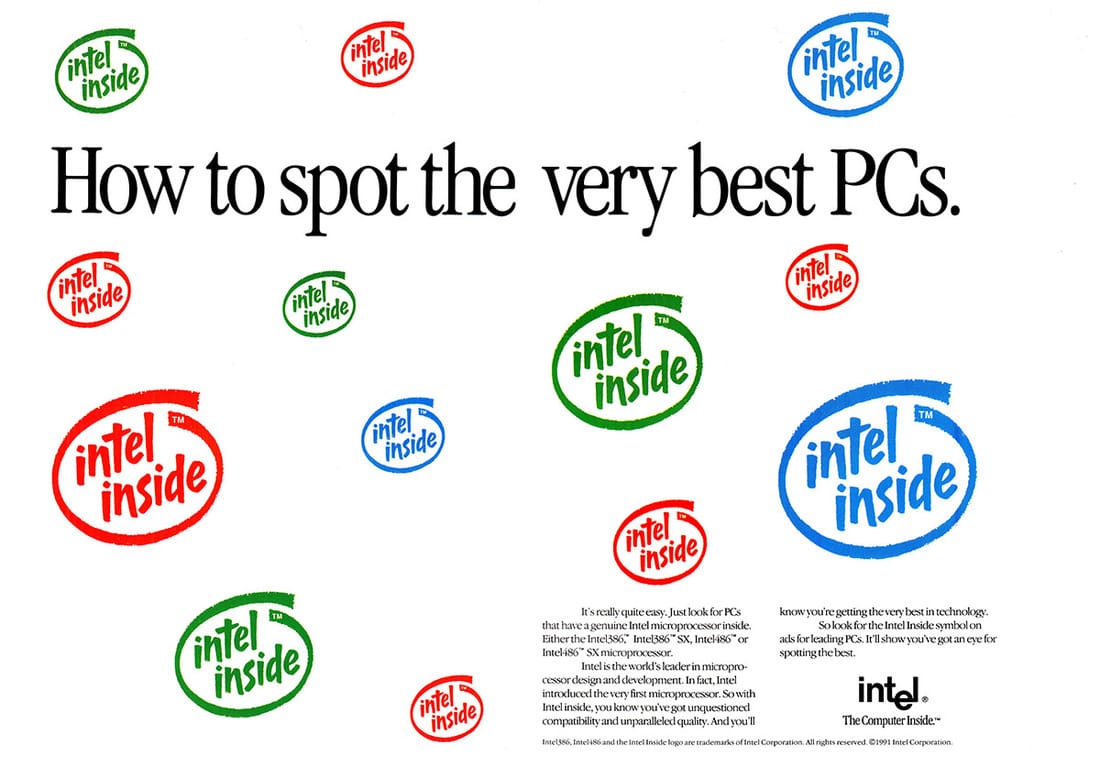“Don’t always go through the tiny little door that everyone is trying to rush through...go around the corner and go through the vast gate that no one’s taking." ~ Peter Thiel
In some cases, the impact of your technology remains unseen by the general public. Whether you're involved in microprocessors, infrastructure blockchain, or cloud computing, the end-user is often unaware that their purchase or application heavily relies on your technology.
So how do you market something invisible?
Position as the essential ingredient.
Ingredient Branding
An ingredient brand strategy is a way to promote a vital component or ingredient within another organization's product or service. In simpler terms, it involves promoting a brand within a brand to the end user.

Instead of directly marketing your own final products to end-users, an ingredient brand strategy aims to establish a component that is trusted and valuable, and is used by other brands.
Success lies in making the ingredient a decisive factor that influences the buying decision in favor of the final product. Ingredient branding is a long-term process where the ingredient becomes an integral part of the final product, inseparable and essential.
Intel Inside
Intel's "Intel Inside" campaign, launched in 1991, stands as a the canonical example of an effective ingredient brand. Facing fierce competition from AMD and a declining market share, Intel needed to establish itself in the minds of consumers.

To achieve this, Intel negotiated to have its processors included in various original equipment manufacturer brands like Compaq and IBM. They invested a substantial $110 million in advertising to emphasize the presence of Intel inside these products, positioning Intel as the component justifying the premium price of PCs.
PC partners prominently displayed the "Intel Inside" logo on their products and in advertisements. As part of the campaign, Intel offered a 6% rebate on microprocessor purchases, which went toward the partner's advertising budget, covering up to 50% of the advertising costs.

This successful campaign resulted in nearly a 12-fold increase in net income for Intel, making their microprocessor brand a crucial factor driving consumer decisions in the personal computer purchasing process.
Synergize, don't Compete
Ingredient brands operate by distinct principles compared to consumer-facing brands. They synergize with other brands rather than compete. They work internally and may not have visual identification.

Their commitment to quality extends to the host brand they're integrated into, benefiting both brands. As a result, the products they enhance enjoy the association with the ingredient brand, potentially delivering superior value to end users.
By becoming an ingredient brand, a brand gains the ability to command higher prices and increase profitability.
Ingredient Branding ≠ Co-Branding
Ingredient branding and co-branding differ in terms of duration and focus. Ingredient branding is a long-term strategy that emphasizes a specific component or brand attribute, integrating it inseparably into the final product. It builds awareness, differentiation, and preference for the product throughout the value chain.

On the other hand, co-branding involves combining two finished consumer products within a single product or service. It aims to leverage the brand equity of each partner to enhance the overall success of the product. Co-branding is more promotional in nature and has a short-to mid-term orientation.
Multipliers of Ingredient Brands

When a brand becomes an ingredient, it can achieve a multiplier effect by:
- Enhanced credibility. By being a trusted ingredient in other brands' products, the brand gains credibility and validation. This fosters end-user trust and a positive perception of the brand.
- Expanded reach. As an ingredient, the brand extends its presence beyond its own offerings, entering new markets and customer segments through brand partnerships. This increases brand visibility and access to a wider audience.
- Success association. The success of brands using the ingredient reflects positively on the ingredient brand, leading to increased sales, market share, and user satisfaction.
- Differentiation. Positioning as a valuable ingredient sets the brand apart from competitors, emphasizing its unique value proposition and giving it a competitive edge.
- Word-of-Mouth. Positive experiences with products containing the ingredient lead to consumers sharing their recommendations, creating word-of-mouth promotion and generating additional awareness and interest in the ingredient brand.
- Long-Term Partnerships. Strategic partnerships with other brands in ingredient branding result in long-term collaborations and shared marketing efforts, further amplifying the brand's exposure and impact.

